
%20JPG.jpg) |
|
Most railways were pretty much
complete when they wrote to the Board of Trade, the main railway
regulator and safety authority of the time, and asked for an
inspection. Not the WVR. After opening it spent the next four
years communicating with the Board of Trade requesting extensions
for various things which it was supposed to have built before
it opened. These are detailed in a nice fat bundle of letters,
compiled by the Board of Trade and now to be found in the Public
Record Office.
At the end of April 1876 the
Engineer, S.H. Yockney, wrote to the Board of Trade from his
offices in Wye Cottages, Tidenham. He wanted to inform the Board
that the railway was now nearly ready for inspection. Some months
later the Company got around to providing the requested paperwork
for the line. On the 22nd of September it reported that the railway
should be ready for inspection from the 27th and wanted a precise
date for the Inspector's visit. The Inspector visited on the
30th of September and wrote his report. This suggested some tweaks
(which are illegible) and said that the railway could open in
a month or so.
A few small points of interest
crop up in the report. The railway was single track but bridges
were wide enough for double track. Enough land had also been
purchased for the second line, although it is again often not
clear how this second line would have fitted in. A second line
was eventually laid over the ¼-mile north of Tidenham
station for the use of Dayhouse Quarry, but this step was not
taken until 1981. A loop was provided in the 1930s for Tintern
Quarry and this presumably took advantage of some of this extra
room.
Details are provided explaining
what structures the railway had built. The largest were the two
viaducts (Tintern and Penallt) and two tunnels (Tintern and Tidenham).
There were four stations, at Tidenham, Tintern, Bigsweir and
Redbrook. The line was 14 miles long with the sharpest curve
at 12 chains and the steepest gradient at 1-in-66. Aside from
the two overbridges, there were 14 underbridges and two authorised
level crossings (Bigsweir and Whitebrook). This last is important,
as there was also one unauthorised level crossing on the Bishton
lane between Tidenham station and Tidenham Tunnel, which the
Railway was instructed to replace with a third overbridge as
soon as possible.
The Railway answered on the
16th of October with a letter explaining that most of the alterations
were now complete, although there was no crossing keeper's house
at Whitebrook and no bridge at Bishton. The Board of Trade asked
for details of the Railway's terminal stations. The Railway said
that it didn't have any (it ended at junctions at both ends and
while Monmouth Troy was essentially the northern terminus the
WVR's metals ended a mile short of this station). It then followed
this up with another letter asking for the Board of Trade for
a copy of their last letter because they had neglected to take
one. |
|
The Great Western Railway began
operating the new line at the beginning of November 1876, but
rapidly drew the WVR's attention to another omission. One of
the issues raised with the neighbouring Ross and Monmouth Railway
when it opened had been that it did not have a turntable at its
Monmouth terminus. Turntables are used to turn locomotives around
so that they are facing back the way that they came - three point
turns are difficult with 40foot locomotives. While little tank
engines can run in either direction equally well, larger steam
locomotives tend to have a tender behind carrying the coal and
water, while the main body merely burns the coal to boil the
water, creating steam to power the train. This allows the main
body of the locomotive to be bigger and more powerful without
being too heavy. However, the weight and size of the tender means
that locomotives with tenders are rarely allowed to push them,
since the crew can't see so well and the loco is less stable
at speed, so a turntable is used to allow the locomotive to be
turned and go back down the line with its tender behind. Speed
was not really an issue on the Wye Valley lines and only one
tender engine ever worked to Monmouth (for Charles Stuart Rolls's
funeral; there is no reason why any others should have wanted
to) but the Great Western had signed up to an agreement that
said that the Wye Valley Railway should provide turntables at
Monmouth and Chepstow, just in case the Great Western ever wanted
to send a tender engine that way. |
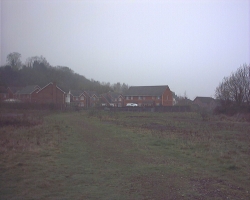
The former goods yard at Monmouth
Troy station in 2005. The turntable would probably have been
on the right. In the absence of a turntable the station never
saw tender engines. |
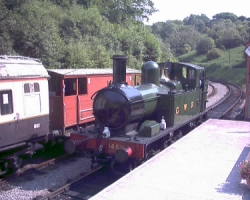
Tank engines - like this Great
Western 1400 class - were preferred traction for rural branch
lines. This one now lives a few miles from Monmouth in the depths
of the Dean Forest. |
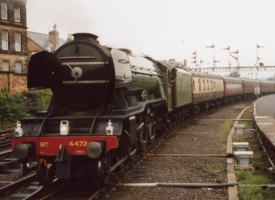
Tender engines tend to be much
larger than tank engines and former London and North Eastern
Railway A3 class No.4472 is possibly the most famous example
of the genre. |

Although rather more than 42
feet long, Didcot's turntable is one of the few remaining in
the country. Most preserved railways do not have one and their
tender engines run tender first half the time. |
|
|
Enter 1877 and on the 16th
of January the WVR wrote to the Board of Trade to explain that
it had organised groundwork for turntables at Monmouth and Chepstow
but was not going to be completed by the due date. It wanted
some more time. The Board of Trade duly consented to this 6 days
later.
On the 14th of March the Great
Western wrote to the Board of Trade laying out the situation
and explaining that, while they waited for the turntables to
appear, tank engines were being supplied. The Board of Trade
duly wrote to the WVR and asked for an update. The WVR took quite
a while to organise this update but eventually explained on the
20th of April that the Chepstow turntable had been delivered
and was ready to be installed. The Monmouth turntable had been
put together and was now awaiting delivery. It was a 42foot turntable,
quite short by turntable standards (about 12 metres or four Mini
cars long) but quite large when compared with Monmouth goods
yard. Therefore some more land was needed. The WVR had apparently
sorted out a piece of land and asked the Duke of Beaufort for
it. The Duke had requested that money owed to him by the railways
(the WVR inferred that it was owed by the other railways) should
be repaid first. The Great Western had apparently declined but
the WVR had settled some kind of deal and the turntable would
be ready shortly.
The Chepstow turntable was
commissioned on the 30th of April 1877. It was located at the
south-western end of the Chepstow station site and was probably
42foot long. In the absence of any rows over it, details in the
letters were able to remain sketchy. Meanwhile the next letter,
on the 24th of May, concerns the completion of the gatekeeper's
lodge at Whitebrook, which the Board of Trade promised to inspect
as soon as possible. |
|
Monmouth's turntable was once
again an issue for those involved towards the end of June when
the Great Western reminded the Board of Trade of the situation.
The Board of Trade asked the WVR for another update. A holding
letter with flowery heading (Wye Valley Railway Co of 53 King
William Street) acknowleged receipt nearly a month later. The
final letter was sent on the 31st of July explaining that the
Duke was still being difficult and requesting another extension.
This was granted and the Wye Valley Railway reminded that it
should move over to tender engines once thet turntable had been
installed.
The next extension request,
on the 23rd of October, was for another six months in which to
build a bridge for Bishton Lane to cross the railway. The Board
of Trade did not sound very happy, but the request was granted.
The 17th of November saw the
WVR send another letter to the Board of Trade apologising for
the ongoing delays to their turntable but explaining that it
was because the Duke's solicitors wouldn't co-operate. The Board
of Trade decided to write to the solicitor directly and explained
to him that the turntable was essential for public safety. They
seemed to be somewhat surprised when the solicitor said that
this was the first he'd heard of the matter for six months, when
he had received a distinctly unforthcoming letter from the railway's
engineer S.H. Yockney saying that the Railway was thinking about
it. As far as the solicitor was concerned the matter was over.
He included copies of the letters. The next letter the WVR received
from the Board was one which hoped that the Directors would explain
matters at the earliest possible opportunity.
The WVR's solicitors, in their
reply two weeks later, blamed the Duke's solicitor. They said
that he had rejected their offers and demanded £5 for the
land, with threats of insisting on a professional valuation if
they didn't pay. It was suggested that they could ignore Baker
but not get the turntable or accept his demands but have to spend
far more than planned on the turntable. It was felt that all
corresponding with Baker did was cost the railway money. The
Board of Trade just gave the Railway another extension. |
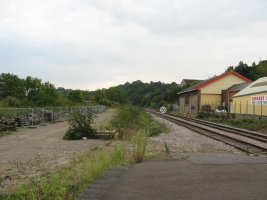
Chepstow's turntable was installed
in 1877 and lasted about 40 years. The site has now been demolished
- in the 1910s the line to the docks was run through it, and
though that has long since gone too there is little evidence
of its existence. |
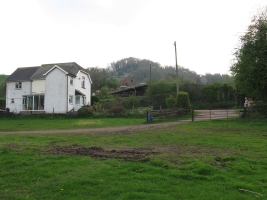
Whitebrook crossing keeper's
house has been extensively extended since its construction. It
is seen here at the age of 122, with the crossing to the right
and various additions on the back and this side. |

The railway's initial headquarters
were in 53 King William Street at the north end of London Bridge.
The current building on this site is the right age but rather
large - presumably it was shared. |
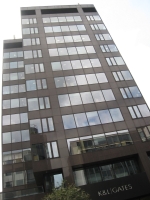
After a period in Chepstow
the railway returned to London at 110 Canon Street, which, just
down the road from Halifax and opposite McDonalds, has changed
a bit over the ensuing years. |
|
|
Bishton Bridge was finished
and ready for inspection by July 23rd 1878 after nearly six months
of silence. Six days later another letter from the WVR sounded
suspiciously as though it wanted the Board of Trade to grant
them compulsory purchase powers if they couldn't have another
extension on their turntable. They got another extension. On
the 31st of August the Board of Trade approved Bishton Bridge
for general use and the number of issues for the WVR to solve
slumped to 1 as Bishton level crossing was removed.
The 20th of September 1878
saw the GWR acknowledge the further extension and emphasise that
they were under no obligations as to how they chose to work the
railway (which probably translates as saying that they could
continue to use tank engines indefinitely). The Board of Trade
passed this information on to the WVR, hoping that no more extensions
would be needed.
Come 1879 and it was not until
the 7th of February that the Board heard from the WVR again.
It was having more problems with its turntable. The Duke had
finally sold the land - but not to them (a name is provided but
it is illegible). This someone else appeared to be putting a
siding on it. With the loss of the preferred location, the WVR
wanted another extension. As a PS, they added that the Board
might want to note that the Company had moved to Chepstow. This
was noted and a three-month extension granted.
Following this extension the
WVR wrote again on July 14th asking for another extension while
they sought Parliamentary powers for their turntable. Parliament
had gone into recess for the summer so the WVR had until October
to organise this Bill; the extension was granted on the basis
that it would be submitted as soon as possible. Until then tank
engines would continue.
No further mention is made
for a year and the next time the railway crops up is 53 weeks
later. The Company wrote to the Board of Trade to explain that
it had entered receivership and therefore had no money at all.
It wanted to know if the turntable was really all that essential.
After all, tank engines were being used without issue. The Board
thought about it and on the 4th of August 1880 delivered judgement.
No turntable would be required.
A final Great Western letter
just under four years later settled the matter; there was a turntable
at Chepstow but not at Monmouth so the branch continued to be
worked by tank engines. The Great Western hoped the Board of
Trade was satisfied. As it never commented further, one may assume
that it was. |
|
So came to an end the saga
of the Monmouth turntable. It disappeared and was never heard
of again. Presumably some railway somewhere obtained a second-hand,
never used 42foot turntable in late 1880 once it had been deemed
unneccessary, although it may have been broken up on site (if
it ever existed). The Chepstow turntable had gone by 1920. Tender
engines, as mentioned above, never ventured to Monmouth on regular
services, which was only served by the lighter tank engines and
the Great Western's diesel railcar fleet. There are no records
that diesel locomotives, which almost completely eliminated turntables
in the 1960s due to most designs having good visibility from
cabs at both ends, ever visited Troy station.
The crossing-keeper's house
at Whitebrook is now a well-maintained private residence. The
three overbridges across the Wye Valley line are still standing
today. The arch at Netherhope is in good condition. Just east
of Wye Valley Junction a girder bridge carries an access road
from a farm across the main and branch lines into a field; years
of light use mean it is still in good condition. Heavier use
of the younger Bishton Bridge means that its condition was probably
a reason for the closure of the line between Tidenham and Tintern
Quarry. Constructed across a section of the railway which is
in one of those very shallow cuttings which seem to be there
purely for tax reasons, it is now excitingly (and probably uniquely)
held up by big metal supports which block the running line. For
some time its current owners, Sustrans, were of the opinion that
it should be demolished and replaced with a level crossing for
their new cycleway.
One feels that if the Engineer,
S.H. Yockney, had known about this threatened doom for his final
Wye Valley Railway structure in 1877 he would almost certainly
have used it as a reason for not building the bridge to begin
with. |
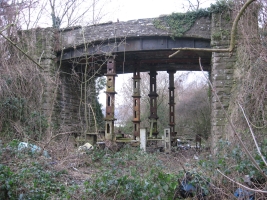
The remains of Bishton Bridge
in January 2009. It was built for double track. The single running
line passes under the left side of the bridge under the four
girders and their supports. |

Small diesels like this one,
seen in 2006 at Parkend, took over the remaining Great Western
branch line freight traffic in the 1960s. Few such locos or branch
lines survived beyond 1970. |
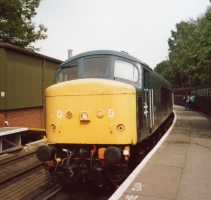
Larger diesels finished off
turntables and tender engines in the 1960s but very few of the
pioneering designs - such as this 138ton 'Peak' - remain in traffic. |
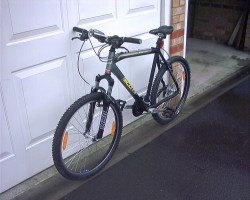
A cycleway is now deemed to
be the future for the WVR; it is progressing almost as well as
Monmouth's turntable. This vehicle was stolen from under the
watchful eye of a CCTV camera in 2008. |
|
|
|



%20JPG.jpg)